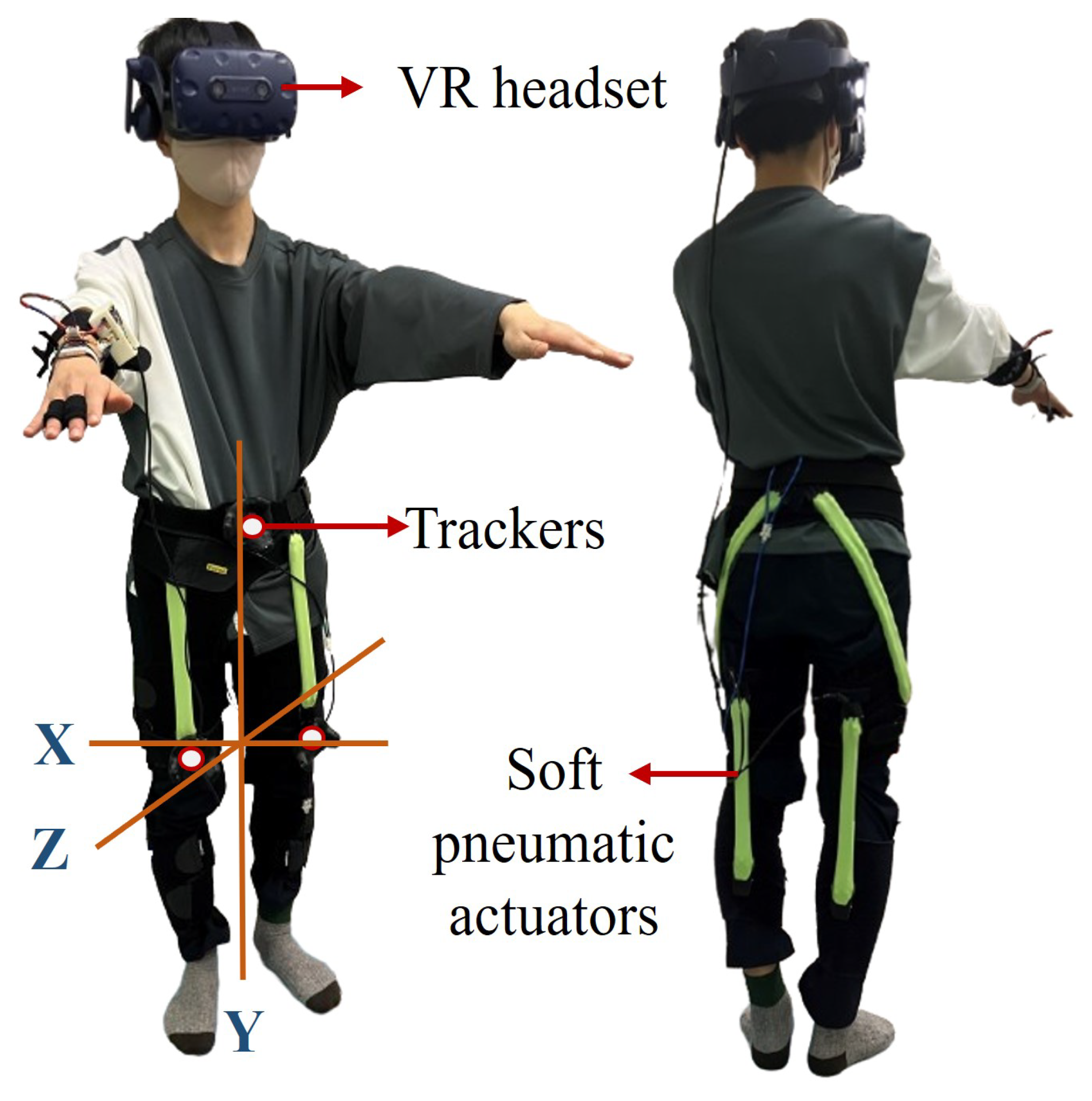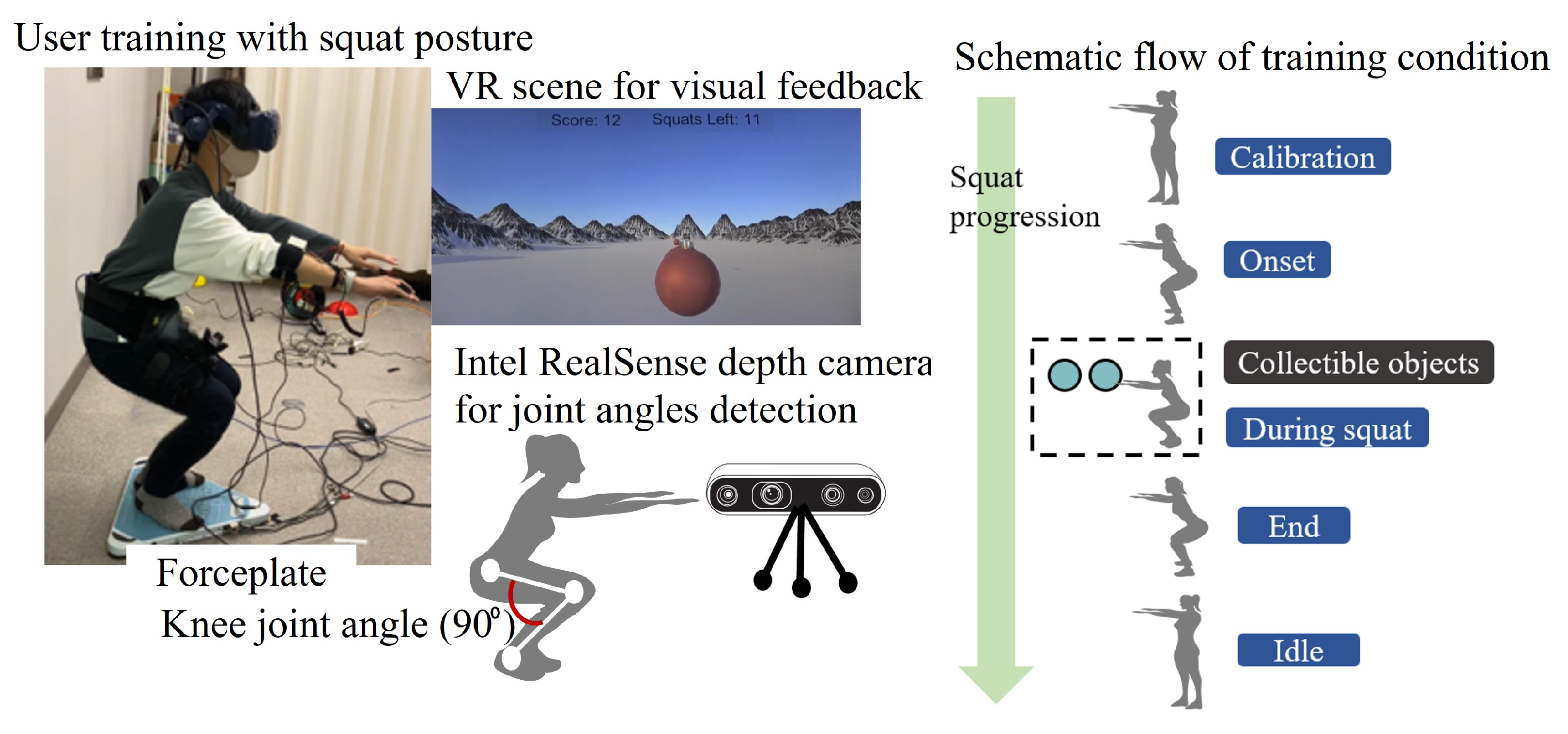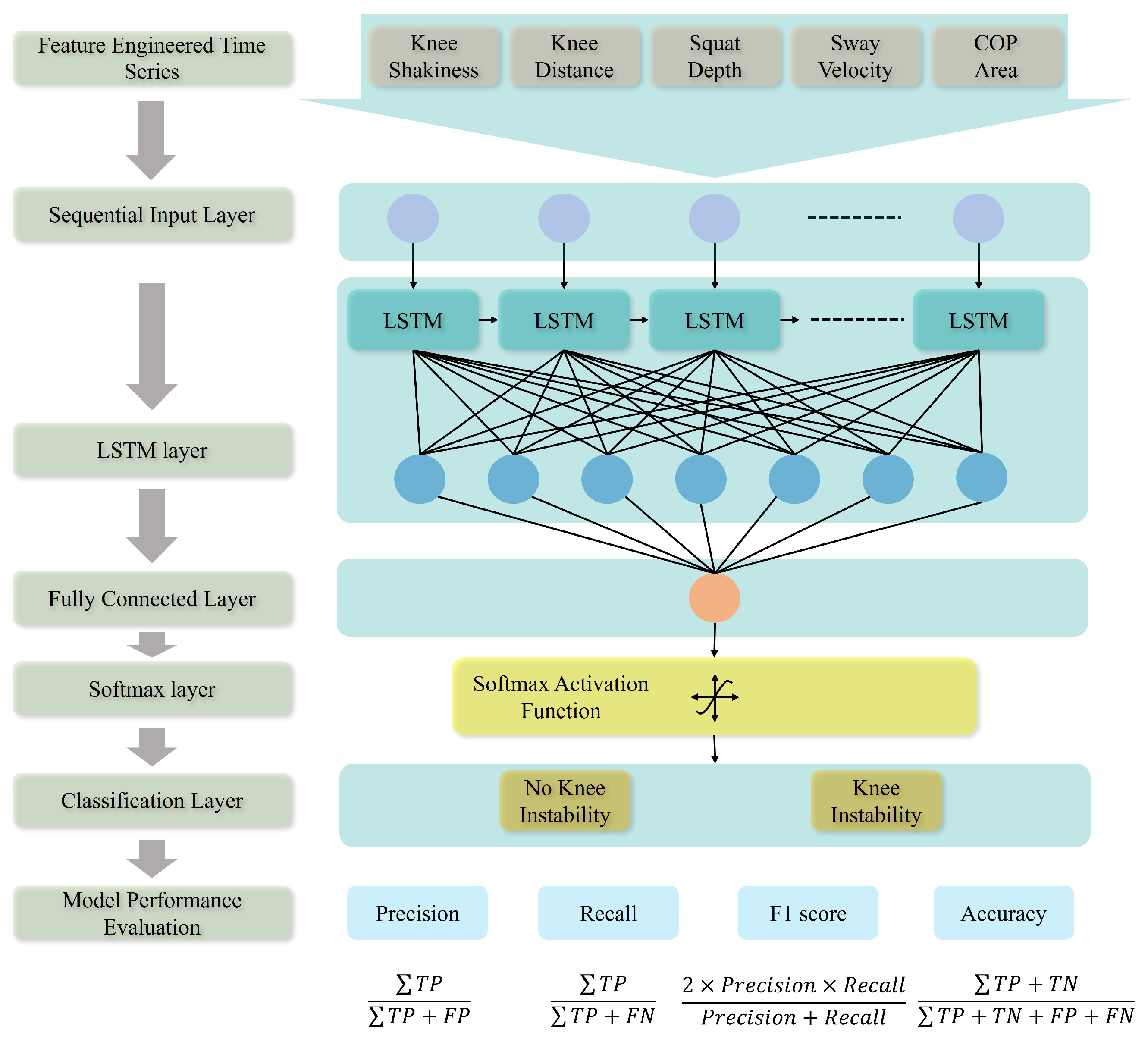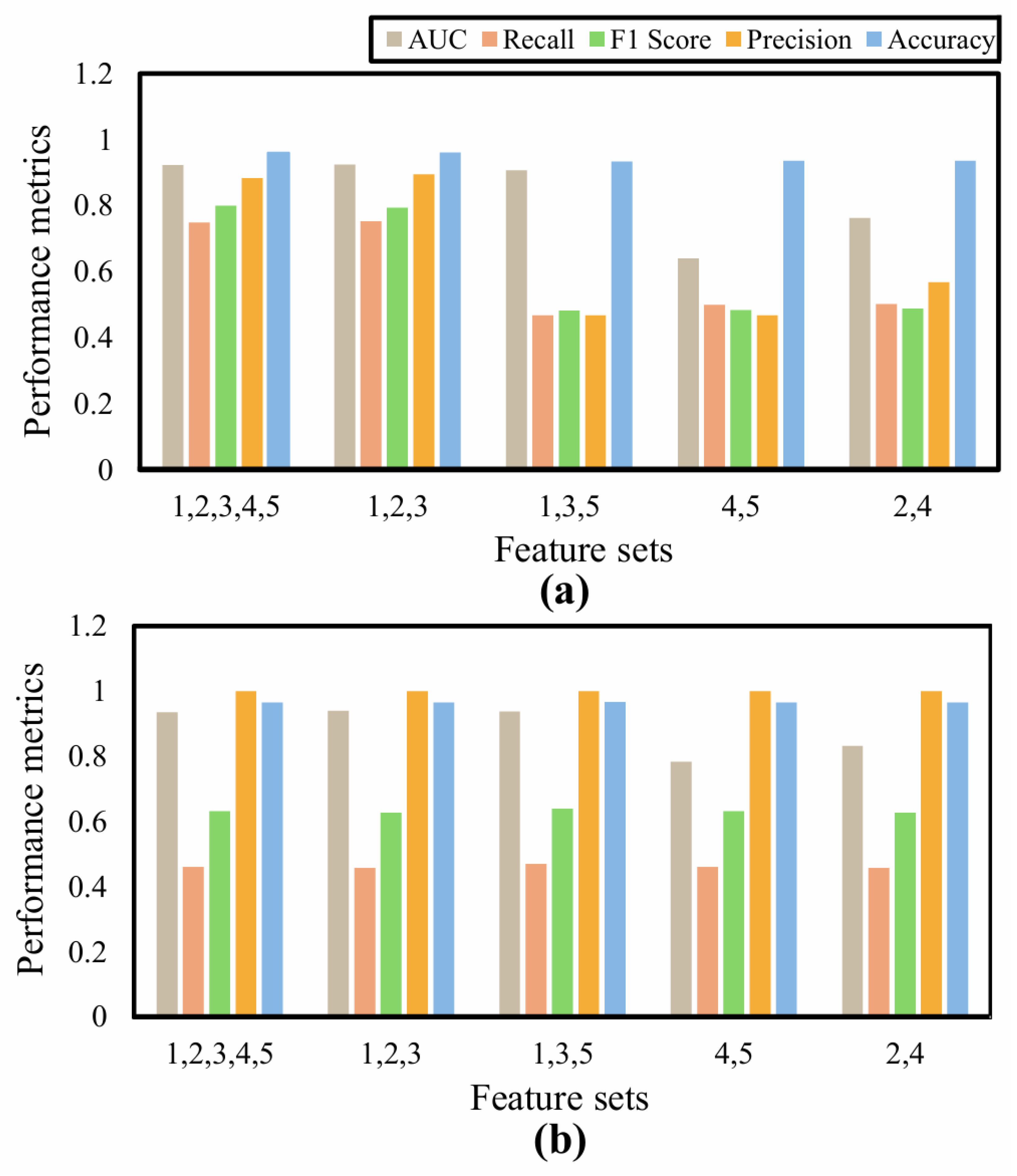A Preliminary Data-Driven Approach for Classifying Knee Instability During Subject-Specific Exercise-Based Game with Squat Motions
Abstract
1. Introduction
2. Related Work
3. Materials and Methods
3.1. Gameplay Configuration
3.2. Participants
3.3. Experimental Protocol
3.4. Data Collection and Preprocessing
3.5. Feature Selection
3.5.1. Long Short-Term Memory Neural Network (LSTM)
Input Layer
LSTM Layer
Classification Layer
3.5.2. Support Vector Machine (SVM)
4. Results and Discussion
4.1. Feature Based Comparison
4.2. Performance Evaluation of LSTM and SVM Based on Feature Sets
- AUC (Area Under Curve)
- Precision
- Recall
- F1 score
5. Conclusions
Supplementary Materials
Author Contributions
Funding
Institutional Review Board Statement
Informed Consent Statement
Data Availability Statement
Conflicts of Interest
Abbreviations
| LSTM | Long Short-Term Memory |
| SVM | Support Vector Machine |
| ACL | Anterior Cruciate Ligament |
| PCL | Posterior Cruciate Ligament |
| KI | Knee Instability |
| NKI | Non-Knee Instability |
| PGM | Pneumatic Gel Muscle |
| VR | Virtual Reality |
| ANN | Artificial Neural Network |
| RNN | Recurrent Neural Network |
| IMU | Inertial Measurement Unit |
| CoP | Center of Pressure |
| FPS | Frames Per Second |
| KS | Knee Shakiness |
| KD | Knee Distance |
| SD | Squat Depth |
| SV | Sway Velocity |
| SA | Sway Area |
| RBF | Radial Basis Function |
| SMO | Sequential Minimal Optimization |
References
- Brown, R.T.; Diaz-Ramirez, L.G.; Boscardin, W.J.; Cappola, A.R.; Lee, S.J.; Steinman, M.A. Changes in the hierarchy of functional impairment from middle age to older age. J. Gerontol. Ser. A 2022, 77, 1577–1584. [Google Scholar] [CrossRef] [PubMed]
- Schättin, A.; Pickles, J.; Flagmeier, D.; Schärer, B.; Riederer, Y.; Niedecken, S.; Villiger, S.; Jurt, R.; Kind, N.; Scott, S.N.; et al. Development of a novel home-based Exergame with on-body feedback: Usability study. JMIR Serious Games 2022, 10, e38703. [Google Scholar] [CrossRef] [PubMed]
- Rusu, L.; Mocanu, I.; Jecan, S.; Sitar, D. Monitoring adaptive exergame for seniors. J. Inf. Syst. Oper. Manag. 2016, 336. [Google Scholar]
- Gerling, K.M.; Schild, J.; Masuch, M. Exergame design for elderly users: The case study of SilverBalance. In Proceedings of the 7th International Conference on Advances in Computer Entertainment Technology, Taipei, Taiwan, 17–19 November 2010; pp. 66–69. [Google Scholar]
- Zhang, H.; Miao, C.; Wu, Q.; Tao, X.; Shen, Z. The effect of familiarity on older adults’ engagement in exergames. In Human Aspects of IT for the Aged Population. Social Media, Games and Assistive Environments, Proceedings of the 5th International Conference, ITAP 2019, Held as Part of the 21st HCI International Conference, HCII 2019, Orlando, FL, USA, 26–31 July 2019; Proceedings, Part II 21; Springer: Cham, Switzerland, 2019; pp. 277–288. [Google Scholar]
- Sinclair, J.; Hingston, P.; Masek, M. Considerations for the design of exergames. In Proceedings of the 5th International Conference on Computer Graphics and Interactive Techniques in Australia and Southeast Asia, Perth, Australia, 1–4 December 2007; pp. 289–295. [Google Scholar]
- Lorenzetti, S.; Gülay, T.; Stoop, M.; List, R.; Gerber, H.; Schellenberg, F.; Stüssi, E. Comparison of the angles and corresponding moments in the knee and hip during restricted and unrestricted squats. J. Strength Cond. Res. 2012, 26, 2829–2836. [Google Scholar] [CrossRef]
- Escamilla, R.F. Knee biomechanics of the dynamic squat exercise. Med. Sci. Sport. Exerc. 2001, 33, 127–141. [Google Scholar] [CrossRef]
- Escamilla, R.F.; Fleisig, G.S.; Zheng, N.; Lander, J.E.; Barrentine, S.W.; Andrews, J.R.; Bergemann, B.W.; Moorman, C.T., III. Effects of technique variations on knee biomechanics during the squat and leg press. Med. Sci. Sport. Exerc. 2001, 33, 1552–1566. [Google Scholar] [CrossRef]
- He, X.; Chow, M.C.S.; Qiu, J.; Fu, S.C.; Mok, K.M.; Ong, M.T.Y.; Fong, D.T.; Yung, P.S.H. Knee wobbling during the single-leg-squat-and-hold test reflects dynamic knee instability in patients with anterior cruciate ligament injury. Res. Sport. Med. 2024, 32, 363–374. [Google Scholar] [CrossRef]
- Aoki, A.; Kubota, S.; Morinaga, K.; Zheng, N.N.; Wang, S.S.; Gamada, K. Detection of knee wobbling as a screen to identify athletes who may be at high risk for ACL injury. Int. Biomech. 2021, 8, 30–41. [Google Scholar] [CrossRef]
- Ramasamy, P.; Das, S.; Kurita, Y. Ski for squat: A squat exergame with pneumatic gel muscle-based dynamic difficulty adjustment. In Proceedings of the International Conference on Human-Computer Interaction, Virtual Event, 24–29 July 2021; pp. 449–467. [Google Scholar]
- Ramasamy, P.; Renganathan, G.; Kurita, Y. Force Feedback-Based Gamification: Performance Validation of Squat Exergame Using Pneumatic Gel Muscles and Dynamic Difficulty Adjustment. IEEE Robot. Autom. Lett. 2023, 8, 6371–6378. [Google Scholar] [CrossRef]
- Okumura, T.; Kurita, Y. Cross-modal effect of presenting visual and force feedback that create the illusion of stair-climbing. Appl. Sci. 2021, 11, 2987. [Google Scholar] [CrossRef]
- Zapata, B.; Narváez, F.; García, M.T.; Zapata, D. Automatic Classification of Squat Execution Based on Inertial Sensors and Machine Learning. In Proceedings of the International Conference on Science, Technology and Innovation for Society, Guayaquil, Ecuador, 26–28 July 2023; pp. 293–307. [Google Scholar]
- Liu, H. Value evaluation of knee joint sports injury detection model-aided diagnosis based on machine learning. Front. Phys. 2023, 11, 1166275. [Google Scholar] [CrossRef]
- Girase, H.; Nyayapati, P.; Booker, J.; Lotz, J.C.; Bailey, J.F.; Matthew, R.P. Automated assessment and classification of spine, hip, and knee pathologies from sit-to-stand movements collected in clinical practice. J. Biomech. 2021, 128, 110786. [Google Scholar] [CrossRef] [PubMed]
- Taborri, J.; Molinaro, L.; Santospagnuolo, A.; Vetrano, M.; Vulpiani, M.C.; Rossi, S. A machine-learning approach to measure the anterior cruciate ligament injury risk in female basketball players. Sensors 2021, 21, 3141. [Google Scholar] [CrossRef] [PubMed]
- Zeng, W.; Ismail, S.A.; Pappas, E. The impact of feature extraction and selection for the classification of gait patterns between ACL deficient and intact knees based on different classification models. EURASIP J. Adv. Signal Process. 2021, 2021, 95. [Google Scholar] [CrossRef]
- Vijayvargiya, A.; Kumar, R.; Dey, N.; Tavares, J.M.R. Comparative analysis of machine learning techniques for the classification of knee abnormality. In Proceedings of the 2020 IEEE 5th International Conference on Computing Communication and Automation (ICCCA), Greater Noida, India, 30–31 October 2020; pp. 1–6. [Google Scholar]
- Liu, B.; Chen, Z.; Hu, Y. Lower limb motion recognition by integrating multi-modal features based on machine learning method. In Proceedings of the 4th International Conference on Computer Science and Application Engineering, Sanya, China, 20–22 October 2020; pp. 1–6. [Google Scholar]
- Moghadam, S.M.; Yeung, T.; Choisne, J. A comparison of machine learning models’ accuracy in predicting lower-limb joints’ kinematics, kinetics, and muscle forces from wearable sensors. Sci. Rep. 2023, 13, 5046. [Google Scholar] [CrossRef]
- Oh, S.; Kim, D.K. Development of squat posture guidance system using kinect and wii balance board. J. Inf. Commun. Converg. Eng. 2019, 17, 74–83. [Google Scholar]
- Vijayvargiya, A.; Singh, B.; Kumari, N.; Kumar, R. sEMG-based deep learning framework for the automatic detection of knee abnormality. Signal, Image Video Process. 2023, 17, 1087–1095. [Google Scholar] [CrossRef]
- Narayan, J.; Johri, S.; Dwivedy, S.K. LSTM neural network-based classification of sensory signals for healthy and unhealthy gait assessment. In Predictive Modeling in Biomedical Data Mining and Analysis; Elsevier: Amsterdam, The Netherlands, 2022; pp. 207–223. [Google Scholar]
- Shayestegan, M.; Kohout, J.; Trnková, K.; Chovanec, M.; Mareš, J. Motion tracking in diagnosis: Gait disorders classification with a dual-head attentional transformer-LSTM. Int. J. Comput. Intell. Syst. 2023, 16, 98. [Google Scholar] [CrossRef]
- Hülsmann, F.; Göpfert, J.P.; Hammer, B.; Kopp, S.; Botsch, M. Classification of motor errors to provide real-time feedback for sports coaching in virtual reality—A case study in squats and Tai Chi pushes. Comput. Graph. 2018, 76, 47–59. [Google Scholar] [CrossRef]
- Kou, J.; Xu, X.; Ni, X.; Ma, S.; Guo, L. Fall-risk assessment of aged workers using wearable inertial measurement units based on machine learning. Saf. Sci. 2024, 176, 106551. [Google Scholar] [CrossRef]
- Novak, D.; Riener, R. Control strategies and artificial intelligence in rehabilitation robotics. Ai Mag. 2015, 36, 23–33. [Google Scholar] [CrossRef]
- Tadayon, R.; Vega Ramirez, A.; Das, S.; Kishishita, Y.; Yamamoto, M.; Kurita, Y. Automatic exercise assistance for the elderly using real-time adaptation to performance and affect. In Universal Access in Human-Computer Interaction. Multimodality and Assistive Environments, Proceedings of the 13th International Conference, UAHCI 2019, Held as Part of the 21st HCI International Conference, HCII 2019, Orlando, FL, USA, 26–31 July 2019; Proceedings, Part II 21; Springer: Cham, Switzerland, 2019; pp. 556–574. [Google Scholar]
- Cary, F.; Postolache, O.; Girao, P.S. Kinect based system and artificial neural networks classifiers for physiotherapy assessment. In Proceedings of the 2014 IEEE International Symposium on Medical Measurements and Applications (MeMeA), Lisboa, Portugal, 11–12 June 2014; pp. 1–6. [Google Scholar]
- Vonstad, E.K.; Vereijken, B.; Bach, K.; Su, X.; Nilsen, J.H. Assessment of Machine Learning Models for Classification of Movement Patterns During a Weight-Shifting Exergame. IEEE Trans. Hum.-Mach. Syst. 2021, 51, 242–252. [Google Scholar] [CrossRef]
- Ma, Z.; Fang, L.; Fang, C.; Chen, F.; Xing, S.P.; Chai, B.; Zheng, Z.; Wang, S.J. Intelligent wearable system design for personalized knee motion and swelling monitoring in osteoarthritis care. Cell Rep. Phys. Sci. 2025, 6, 102438. [Google Scholar] [CrossRef]
- Zheng, Y.; Wang, Y.; Liu, J.; Jiang, H.; Yue, Q. Knee joint vibration signal classification algorithm based on machine learning. Neural Comput. Appl. 2021, 33, 985–995. [Google Scholar] [CrossRef]
- Liu, Y.; Su, Z.; Li, H.; Zhang, Y. An LSTM based classification method for time series trend forecasting. In Proceedings of the 2019 14th IEEE Conference on Industrial Electronics and Applications (ICIEA), Xi’an, China, 19–21 June 2019; pp. 402–406. [Google Scholar] [CrossRef]
- Straub, R.K.; Powers, C.M. A biomechanical review of the squat exercise: Implications for clinical practice. Int. J. Sport. Phys. Ther. 2024, 19, 490. [Google Scholar] [CrossRef]
- Quijoux, F.; Nicolaï, A.; Chairi, I.; Bargiotas, I.; Ricard, D.; Yelnik, A.; Oudre, L.; Bertin-Hugault, F.; Vidal, P.P.; Vayatis, N.; et al. A review of center of pressure (COP) variables to quantify standing balance in elderly people: Algorithms and open-access code. Physiol. Rep. 2021, 9, e15067. [Google Scholar]
- Q4E Case Study 30—Squat—Stable/Unstable Base. Proposed Usage in Sports Science/Physiotherapy/Postural Management (A/AS Level/Degree Yr 1/2 Sports Science/Rehabilitation). 2025. Available online: https://www.quinticsports.com/case-study/q4e-case-study-30-squat-stable-unstable-base/ (accessed on 2 July 2025).
- Jiang, J.; Zhang, X.; Yuan, Z. Feature selection for classification with Spearman’s rank correlation coefficient-based self-information in divergence-based fuzzy rough sets. Expert Syst. Appl. 2024, 249, 123633. [Google Scholar] [CrossRef]
- Muhuri, P.S.; Chatterjee, P.; Yuan, X.; Roy, K.; Esterline, A. Using a Long Short-Term Memory Recurrent Neural Network (LSTM-RNN) to Classify Network Attacks. Information 2020, 11, 243. [Google Scholar] [CrossRef]
- Hochreiter, S.; Schmidhuber, J. Long Short-Term Memory. Neural Comput. 1997, 9, 1735–1780. [Google Scholar] [CrossRef]
- Kianifar, R.; Lee, A.; Raina, S.; Kulić, D. Classification of squat quality with inertial measurement units in the single leg squat mobility test. In Proceedings of the 2016 38th Annual International Conference of the IEEE Engineering in Medicine and Biology Society (EMBC), Orlando, FL, USA, 16–20 August 2016; pp. 6273–6276. [Google Scholar] [CrossRef]
- Chariar, M.; Rao, S.; Irani, A.; Suresh, S.; Asha, C. AI trainer: Autoencoder based approach for squat analysis and correction. IEEE Access 2023, 11, 107135–107149. [Google Scholar] [CrossRef]
- Cervantes, J.; Garcia-Lamont, F.; Rodríguez-Mazahua, L.; Lopez, A. A comprehensive survey on support vector machine classification: Applications, challenges and trends. Neurocomputing 2020, 408, 189–215. [Google Scholar] [CrossRef]









| Study | Features | Methods | Target Conditions | Accuracy |
|---|---|---|---|---|
| Zapata et al. [15] | Lower limb joint angles | MLP/SVM | Squat posture recognition | MLP: 92% SVM: 72% |
| Liu et al. [16] | Knee joint angles | SVM | Knee joint injury assessment | Not reported |
| Girase et al. [17] | Lower limb joint angles | SVM/RF/MLP | Assessment of lower limb pathologies | MLP: 73% |
| Zeng et al. [5] | 6-DOF-based knee joint angles | SVM/RBF | Knee gait pattern classification | 2-fold RBF: 95.7% 1-fold RBF: 97.9% |
| Taborri et al. [18] | Lower limb joint angles | SVM/KNN/DT | ACL injury assessment | SVM: 96% KNN: 67% DT: Not reported |
| Zeng et al. [19] | Lower limb joint angles | SVM/DT/KNN/NB/ELA | Gait classification including patients with ACL-deficient and intact knees | SVM: (91~96)% DT: (77~83)% KNN: (78~88)% NB: (57~61)% ELA: (73~79)% |
| Vijayvargiya et al. [20] | EMG signals | SVM/DT/KNN/RF/ET | Knee abnormality classification | SVM: 70.1% DT: 70% KNN: 79.3% RF: 88.8% ET: 91.3% |
| Liu et al. [21] | EMG, acceleration, knee angles, foot pressure | LDA/SVM/LM-BP | Lower limb movement intention recognition | LDA: 92.46% |
| Moghadam et al. [22] | Kinematic/kinetic joint data, GRF, muscle forces | CNN/RF/SVM/MARS | ML model comparison for locomotion prediction | Not reported |
| Oh et al. [23] | Shoulder, knee and ankle joint angles and CoP data | SVM/NB | Squat posture recognition | SVM: 95.61% NB: 81.82% |
| Vijayvargiya et al. [24] | EMG signals | Conv-LSTM | Automated knee abnormality detection | LSTM: 98.61% |
| Narayan et al. [25] | knee joints and EMG | LSTM-SGD/LSTM-ADAM | Healthy and impaired gait assessment | LSTM-SGD: 79.18% LSTM-ADAM: 91.72% |
| Mohsen et al. [26] | Upper and lower limb joints | DHAT-LSTM | Gait dysfunction classification | DHAT-LSTM: 81% |
| Felix et al. [27] | Upper and lower limb joints | SVM/KNN-DTW/Conv-LSTM | Movement error classification | Squat-SVM: 56% Squat-KNN-DTW: 80% Squat-Conv-LSTM: 80% |
| Junhui at al. [28] | Upper and lower limb joints | RF/Conv-LSTM | Gait and squat assessment | RF: 91.3% Conv-LSTM: 95.18% |
| Feature Sets | AUC | Recall | F1 Score | Precision | Accuracy (%) |
|---|---|---|---|---|---|
| 1,2,3,4,5 | 0.92 | 0.75 | 0.80 | 0.88 | 96.04 |
| 1,2,3 | 0.91 | 0.75 | 0.79 | 0.90 | 96.13 |
| 1,3,5 | 0.92 | 0.47 | 0.48 | 0.47 | 93.40 |
| 4,5 | 0.64 | 0.50 | 0.48 | 0.47 | 93.57 |
| 2,4 | 0.77 | 0.50 | 0.49 | 0.57 | 93.60 |
| Feature Sets | AUC | Recall | F1 Score | Precision | Accuracy (%) |
|---|---|---|---|---|---|
| 1,2,3,4,5 | 0.94 | 0.46 | 0.63 | 1 | 96.54 |
| 1,2,3 | 0.94 | 0.46 | 0.63 | 1 | 96.51 |
| 1,3,5 | 0.94 | 0.47 | 0.64 | 1 | 96.59 |
| 4,5 | 0.77 | 0.46 | 0.63 | 1 | 96.54 |
| 2,4 | 0.83 | 0.46 | 0.63 | 1 | 96.51 |
Disclaimer/Publisher’s Note: The statements, opinions and data contained in all publications are solely those of the individual author(s) and contributor(s) and not of MDPI and/or the editor(s). MDPI and/or the editor(s) disclaim responsibility for any injury to people or property resulting from any ideas, methods, instructions or products referred to in the content. |
© 2025 by the authors. Licensee MDPI, Basel, Switzerland. This article is an open access article distributed under the terms and conditions of the Creative Commons Attribution (CC BY) license (https://creativecommons.org/licenses/by/4.0/).
Share and Cite
Ramasamy, P.; Palani, P.; Renganathan, G.; Shimatani, K.; Thondiyath, A.; Kurita, Y. A Preliminary Data-Driven Approach for Classifying Knee Instability During Subject-Specific Exercise-Based Game with Squat Motions. Sensors 2025, 25, 6074. https://doi.org/10.3390/s25196074
Ramasamy P, Palani P, Renganathan G, Shimatani K, Thondiyath A, Kurita Y. A Preliminary Data-Driven Approach for Classifying Knee Instability During Subject-Specific Exercise-Based Game with Squat Motions. Sensors. 2025; 25(19):6074. https://doi.org/10.3390/s25196074
Chicago/Turabian StyleRamasamy, Priyanka, Poongavanam Palani, Gunarajulu Renganathan, Koji Shimatani, Asokan Thondiyath, and Yuichi Kurita. 2025. "A Preliminary Data-Driven Approach for Classifying Knee Instability During Subject-Specific Exercise-Based Game with Squat Motions" Sensors 25, no. 19: 6074. https://doi.org/10.3390/s25196074
APA StyleRamasamy, P., Palani, P., Renganathan, G., Shimatani, K., Thondiyath, A., & Kurita, Y. (2025). A Preliminary Data-Driven Approach for Classifying Knee Instability During Subject-Specific Exercise-Based Game with Squat Motions. Sensors, 25(19), 6074. https://doi.org/10.3390/s25196074








